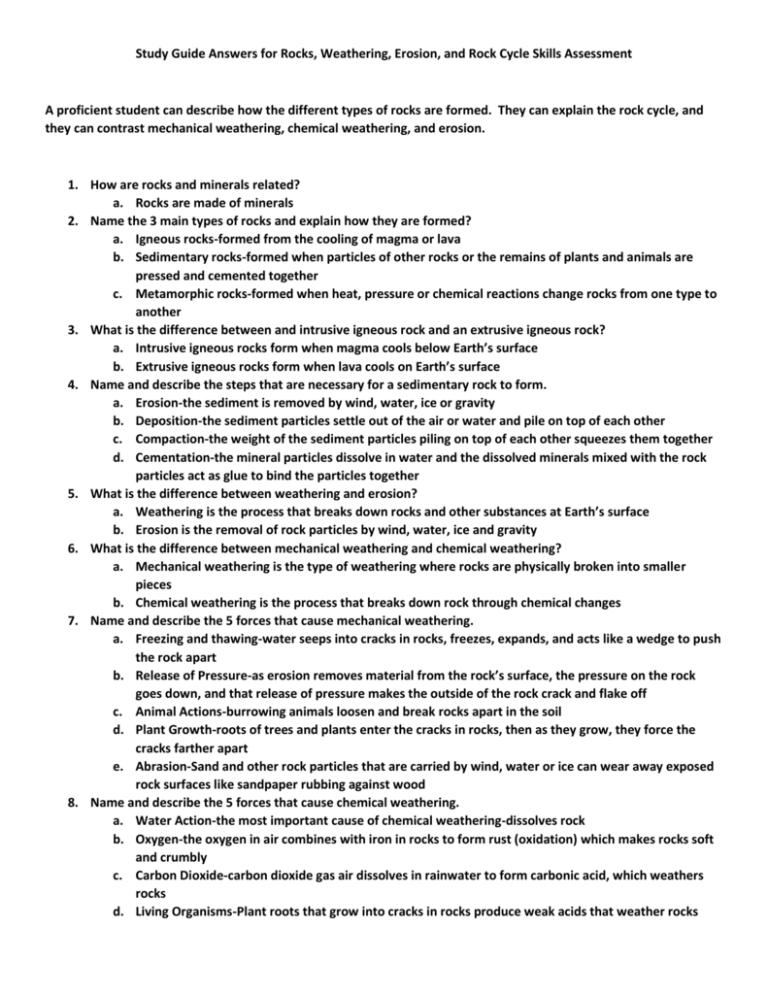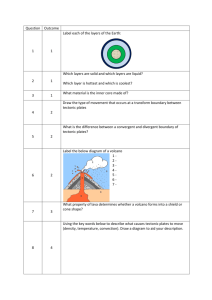Rocks test study guide answer key
advertisement

Study Guide Answers for Rocks, Weathering, Erosion, and Rock Cycle Skills Assessment A proficient student can describe how the different types of rocks are formed. They can explain the rock cycle, and they can contrast mechanical weathering, chemical weathering, and erosion. 1. How are rocks and minerals related? a. Rocks are made of minerals 2. Name the 3 main types of rocks and explain how they are formed? a. Igneous rocks-formed from the cooling of magma or lava b. Sedimentary rocks-formed when particles of other rocks or the remains of plants and animals are pressed and cemented together c. Metamorphic rocks-formed when heat, pressure or chemical reactions change rocks from one type to another 3. What is the difference between and intrusive igneous rock and an extrusive igneous rock? a. Intrusive igneous rocks form when magma cools below Earth’s surface b. Extrusive igneous rocks form when lava cools on Earth’s surface 4. Name and describe the steps that are necessary for a sedimentary rock to form. a. Erosion-the sediment is removed by wind, water, ice or gravity b. Deposition-the sediment particles settle out of the air or water and pile on top of each other c. Compaction-the weight of the sediment particles piling on top of each other squeezes them together d. Cementation-the mineral particles dissolve in water and the dissolved minerals mixed with the rock particles act as glue to bind the particles together 5. What is the difference between weathering and erosion? a. Weathering is the process that breaks down rocks and other substances at Earth’s surface b. Erosion is the removal of rock particles by wind, water, ice and gravity 6. What is the difference between mechanical weathering and chemical weathering? a. Mechanical weathering is the type of weathering where rocks are physically broken into smaller pieces b. Chemical weathering is the process that breaks down rock through chemical changes 7. Name and describe the 5 forces that cause mechanical weathering. a. Freezing and thawing-water seeps into cracks in rocks, freezes, expands, and acts like a wedge to push the rock apart b. Release of Pressure-as erosion removes material from the rock’s surface, the pressure on the rock goes down, and that release of pressure makes the outside of the rock crack and flake off c. Animal Actions-burrowing animals loosen and break rocks apart in the soil d. Plant Growth-roots of trees and plants enter the cracks in rocks, then as they grow, they force the cracks farther apart e. Abrasion-Sand and other rock particles that are carried by wind, water or ice can wear away exposed rock surfaces like sandpaper rubbing against wood 8. Name and describe the 5 forces that cause chemical weathering. a. Water Action-the most important cause of chemical weathering-dissolves rock b. Oxygen-the oxygen in air combines with iron in rocks to form rust (oxidation) which makes rocks soft and crumbly c. Carbon Dioxide-carbon dioxide gas air dissolves in rainwater to form carbonic acid, which weathers rocks d. Living Organisms-Plant roots that grow into cracks in rocks produce weak acids that weather rocks 9. 10. 11. 12. e. Acid Rain-Sulfur, Carbon, and Nitrogen compounds in the air react with water vapor in clouds to form acids. The acids mix with raindrops and fall as acid rain, which weathers rocks very quickly What factors affect the rate a rock weathers? a. The type of rock (the type of mineral in the rock and whether the minerals dissolve easily or not) b. The climat (the average weather conditions) –hot and wet climates weather rocks fast, cold climates and dry climates weather rocks more slowly What is the rock cycle? a. A series of processes on Earth’s surface and in the crust and mantle that slowly change rocks from one kind to another What causes the uplift, folding and faulting that move rocks through the rock cycle? a. Movements of Earth’s tectonic plates Use the rock cycle to describe how the following rocks could change: a. From an igneous rock to a sedimentary rock-the igneous rock is weathered, eroded, deposited, compacted and cemented b. From an igneous rock to a metamorphic rock-it undergoes extreme heat and pressure c. From a sedimentary rock to an igneous rock-it is melted in the mantle and then the magma or lava cools d. From a sedimentary rock to a metamorphic rock-it undergoes extreme heat and pressure e. From a metamorphic rock to an igneous rock-it is melted in the mantle and then magma or lava cools f. From a metamorphic rock to a sedimentary rock-it is weathered, eroded, deposited, compacted and cemented.






